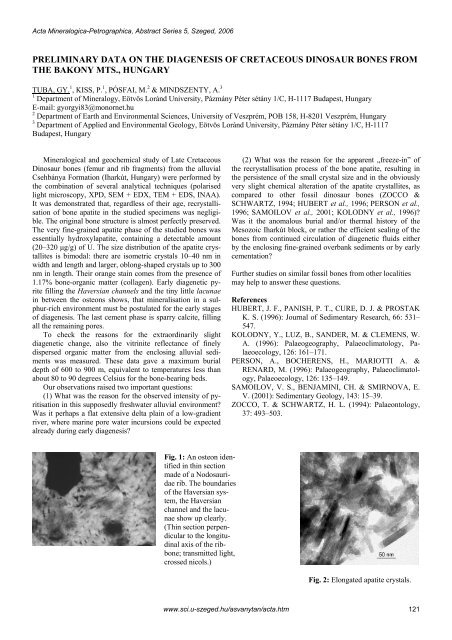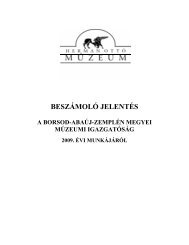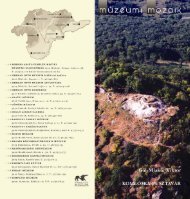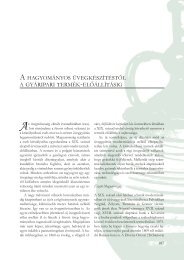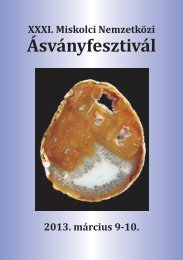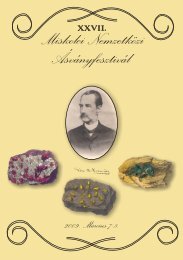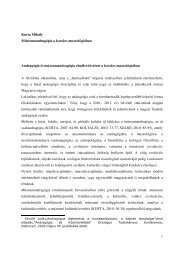Acta Mineralogica-Petrographica, Abstract Series 5, Szeged, 2006CRITICAL EVALUATION OF <strong>THE</strong> ANALYTICAL DATA ON DIOCTAHEDRAL IRON-RICHMICAS AND RELATED <strong>M<strong>IN</strong>ERAL</strong> PHASES PUBLISHED <strong>IN</strong> <strong>THE</strong> LITERATURETÓTH, E. 1 , WEISZBURG, T. G. 1 & POP, D. 21 Department of Mineralogy, Eötvös Loránd University, Pázmány Péter sétány 1/C, H-1117 Budapest, HungaryE-mail: zsike@abyss.elte.hu2 Mineralogical Museum, Babeş-Bolyai University, Kogălniceanu St. 1, Cluj-Napoca, RomaniaFrom many respects, it is hard to obtain high-qualitychemical data of iron-rich dioctahedral micas (the true micaceladonite and the interlayer-deficient mica glauconite) andthe related phases (e.g. “Fe-illite”, “skolite”). Firstly, thesample is often inhomogeneous: the less evolved glauconiticgrains regularly contain inclusions of quartz, feldspar, apatiteetc. and may be stained with iron oxy-hydroxides, whileceladonite, primarily a hydrothermal alteration product ofbasalt, often forms only thin encrustations and is readilymixed with other clay minerals or zeolites. This high grade ofinhomogeneity could still be avoided by the application ofelectron probe microanalysis, however, these minerals containa considerable amount of iron in both valence states, andfor the determination of the Fe 3+ / Fe 2+ ratio either Mössbauerspectroscopy or wet chemistry is needed.Studying the crystal chemical space occupied by theseminerals, we set up a database including all the full chemicaldata accessible in the earth science literature. At the moment,the database contains more than 630 records, allowing us todraw some conclusions on the quality of these data.We found that many authors neglect publishing the measureddata (oxide wt %) and give only the calculated formula(atomic coefficients). These formulae often prove erroneousfrom a crystal chemical point of view, and, without the originaldata, it is impossible to trace back where the mistake wasmade. Several tens of analyses were discredited (suspectingeither mixed material or analytical error) on structural constraintslike Si > 4.0 apfu (formula calculated for 11 O), octahedraloccupancy > 2.5 (official limit for dioctahedral layersilicates), interlayer occupancy > 1.0 etc.Only half of the remaining data, approx. 300 analyses,contained measured FeO–Fe 2 O 3 values with the proportion ofFe 2+ being in the range 0–40%. For those analyses lackingthese values, the authors adopted one of the following processes:they considered the total amount of iron as Fe 3+ , orthey calculated the formula for perfect dioctahedrality (i.e.octahedral occupancy = 2.00), even in such nomenclatureinspiringpapers like LI et al. (1997). From these 300 “complete”analyses we found that the octahedral occupancy hasan approximately normal distribution, with the maximumnear 1.99–2.01 for phases containing K = 0.85–1.00 apfu and2.01–2.03 for K = 0.6–0.85 apfu (values are in the range1.95–2.10). We expect that in our data set the less evolved –pale green, more smectite-like – grains are underrepresented.For showing the effect of the occupancy vs. iron valencestate calculations, as an example, a well-known celadonite(E’ of BUCKLEY et al., 1978) with given FeO–Fe 2 O 3 concentrationswas selected. With increasing octahedral occupancy(oct. occ.), the interlayer charge remained relativelyconstant, however, the amount of divalent iron increaseddramatically: from 6% (oct. occ. = 1.95) to 46% (oct. occ. =2.05). More important, the nomenclature-related (RIEDER etal., 1998) discriminant value VI Al / ( VI Al + VI Fe 3+ ) changedfrom 0.32 to 0.51, crossing the border between Fe-rich andAl-rich members. Inversely, if the amount of Fe 2+ is estimatedto be higher, the octahedral occupancy increases. Itcomes from two facts: (1) due to the lower amount of oxygens(each Fe 3+ is accompanied by 1.5 O, while each Fe 2+ byonly 1 O), a higher normalisation factor is needed for the11 O-based formula, thus the amount of each componentincreases; (2) as the amount of Si increases, it forces part ofthe tetrahedral Al into the octahedral layer. The relationshipbetween the amount of Fe 2+ and the octahedral occupancy islinear.Plotting the formulae into the IMA nomenclature diagram(RIEDER et al., 1998), we found that several, from a crystalchemical point of view acceptable, formulae plot outside thediagonal border of the celadonite and glauconite boxes due toimperfect (≠ 2.00) dioctahedrality. From this respect, plottinginto the IMA diagram should be handled with care.The authors wish to express their gratitude to the EuropeanCommission’s Research Infrastructure Action via theSYN<strong>THE</strong>SYS Project and especially Terry Williams (NHM)for the access to the library of the Natural History Museum(London).ReferencesBUCKLEY, H.A., BEVAN, J.C., BROWN, K.M.,JOHNSON, L.R. & FARMER, V.C. (1978): MineralogicalMagazine, 42:373–382.LI, G., PEACOR, D.R., COOMBS, D.S. & KAWACHI, Y.(1997): American Mineralogist, 82: 503–511.RIEDER, M., CAVAZZ<strong>IN</strong>I, G., D’YAKONOV, Y.,FRANK-KAMENETSKII, V.A., GOTTARDI, G.,GUGGENHEIM, S., KOVAL, P.V., MÜLLER, G.,NEIVA, A.M.R., RADOSLOVICH, E.W., ROBERT, J.-L., SASSI, F.P., TAKEDA, H., WEISS, Z. & WONES,D.R. (1998): Canadian Mineralogist, 36: 905–912.120www.sci.u-szeged.hu/asvanytan/acta.htm
Acta Mineralogica-Petrographica, Abstract Series 5, Szeged, 2006PRELIM<strong>IN</strong>ARY DATA ON <strong>THE</strong> DIAGENESIS OF CRETACEOUS D<strong>IN</strong>OSAUR BONES FROM<strong>THE</strong> BAKONY MTS., HUNGARYTUBA, GY. 1 , KISS, P. 1 , PÓSFAI, M. 2 & M<strong>IN</strong>DSZENTY, A. 31 Department of Mineralogy, Eötvös Loránd University, Pázmány Péter sétány 1/C, H-1117 Budapest, HungaryE-mail: gyorgyi83@monornet.hu2 Department of Earth and Environmental Sciences, University of Veszprém, POB 158, H-8201 Veszprém, Hungary3 Department of Applied and Environmental Geology, Eötvös Loránd University, Pázmány Péter sétány 1/C, H-1117Budapest, HungaryMineralogical and geochemical study of Late CretaceousDinosaur bones (femur and rib fragments) from the alluvialCsehbánya Formation (Iharkút, Hungary) were performed bythe combination of several analytical techniques (polarisedlight microscopy, XPD, SEM + EDX, TEM + EDS, <strong>IN</strong>AA).It was demonstrated that, regardless of their age, recrystallisationof bone apatite in the studied specimens was negligible.The original bone structure is almost perfectly preserved.The very fine-grained apatite phase of the studied bones wasessentially hydroxylapatite, containing a detectable amount(20–320 µg/g) of U. The size distribution of the apatite crystallitesis bimodal: there are isometric crystals 10–40 nm inwidth and length and larger, oblong-shaped crystals up to 300nm in length. Their orange stain comes from the presence of1.17% bone-organic matter (collagen). Early diagenetic pyritefilling the Haversian channels and the tiny little lacunaein between the osteons shows, that mineralisation in a sulphur-richenvironment must be postulated for the early stagesof diagenesis. The last cement phase is sparry calcite, fillingall the remaining pores.To check the reasons for the extraordinarily slightdiagenetic change, also the vitrinite reflectance of finelydispersed organic matter from the enclosing alluvial sedimentswas measured. These data gave a maximum burialdepth of 600 to 900 m, equivalent to temperatures less thanabout 80 to 90 degrees Celsius for the bone-bearing beds.Our observations raised two important questions:(1) What was the reason for the observed intensity of pyritisationin this supposedly freshwater alluvial environment?Was it perhaps a flat extensive delta plain of a low-gradientriver, where marine pore water incursions could be expectedalready during early diagenesis?(2) What was the reason for the apparent „freeze-in” ofthe recrystallisation process of the bone apatite, resulting inthe persistence of the small crystal size and in the obviouslyvery slight chemical alteration of the apatite crystallites, ascompared to other fossil dinosaur bones (ZOCCO &SCHWARTZ, 1994; HUBERT et al., 1996; PERSON et al.,1996; SAMOILOV et al., 2001; KOLODNY et al., 1996)?Was it the anomalous burial and/or thermal history of theMesozoic Iharkút block, or rather the efficient sealing of thebones from continued circulation of diagenetic fluids eitherby the enclosing fine-grained overbank sediments or by earlycementation?Further studies on similar fossil bones from other localitiesmay help to answer these questions.ReferencesHUBERT, J. F., PANISH, P. T., CURE, D. J. & PROSTAKK. S. (1996): Journal of Sedimentary Research, 66: 531–547.KOLODNY, Y., LUZ, B., SANDER, M. & CLEMENS, W.A. (1996): Palaeogeography, Palaeoclimatology, Palaeoecology,126: 161–171.PERSON, A., BOCHERENS, H., MARIOTTI A. &RENARD, M. (1996): Palaeogeography, Palaeoclimatology,Palaeoecology, 126: 135–149.SAMOILOV, V. S., BENJAM<strong>IN</strong>I, CH. & SMIRNOVA, E.V. (2001): Sedimentary Geology, 143: 15–39.ZOCCO, T. & SCHWARTZ, H. L. (1994): Palaeontology,37: 493–503.Fig. 1: An osteon identifiedin thin sectionmade of a Nodosauridaerib. The boundariesof the Haversian system,the Haversianchannel and the lacunaeshow up clearly.(Thin section perpendicularto the longitudinalaxis of the ribbone;transmitted light,crossed nicols.)Fig. 2: Elongated apatite crystals.www.sci.u-szeged.hu/asvanytan/acta.htm 121
- Page 1:
MSCC33 rd MINERAL SCIENCES IN THE C
- Page 5 and 6:
Acta Mineralogica-Petrographica, Ab
- Page 7 and 8:
Acta Mineralogica-Petrographica, Ab
- Page 9 and 10:
Acta Mineralogica-Petrographica, Ab
- Page 11 and 12:
Acta Mineralogica-Petrographica, Ab
- Page 13 and 14:
Acta Mineralogica-Petrographica, Ab
- Page 15 and 16:
Acta Mineralogica-Petrographica, Ab
- Page 17 and 18:
Acta Mineralogica-Petrographica, Ab
- Page 19 and 20:
Acta Mineralogica-Petrographica, Ab
- Page 21 and 22:
Acta Mineralogica-Petrographica, Ab
- Page 23 and 24:
Acta Mineralogica-Petrographica, Ab
- Page 25 and 26:
Acta Mineralogica-Petrographica, Ab
- Page 27 and 28:
Acta Mineralogica-Petrographica, Ab
- Page 29 and 30:
Acta Mineralogica-Petrographica, Ab
- Page 31 and 32:
Acta Mineralogica-Petrographica, Ab
- Page 33 and 34:
Acta Mineralogica-Petrographica, Ab
- Page 35 and 36:
Acta Mineralogica-Petrographica, Ab
- Page 37 and 38:
Acta Mineralogica-Petrographica, Ab
- Page 39 and 40:
Acta Mineralogica-Petrographica, Ab
- Page 41 and 42:
Acta Mineralogica-Petrographica, Ab
- Page 43 and 44:
Acta Mineralogica-Petrographica, Ab
- Page 45 and 46:
Acta Mineralogica-Petrographica, Ab
- Page 47 and 48:
Acta Mineralogica-Petrographica, Ab
- Page 49 and 50:
Acta Mineralogica-Petrographica, Ab
- Page 51 and 52:
Acta Mineralogica-Petrographica, Ab
- Page 53 and 54:
Acta Mineralogica-Petrographica, Ab
- Page 55 and 56:
Acta Mineralogica-Petrographica, Ab
- Page 57 and 58:
Acta Mineralogica-Petrographica, Ab
- Page 59 and 60:
Acta Mineralogica-Petrographica, Ab
- Page 61 and 62:
Acta Mineralogica-Petrographica, Ab
- Page 63 and 64:
Acta Mineralogica-Petrographica, Ab
- Page 65 and 66:
Acta Mineralogica-Petrographica, Ab
- Page 67 and 68:
Acta Mineralogica-Petrographica, Ab
- Page 69 and 70: Acta Mineralogica-Petrographica, Ab
- Page 71 and 72: Acta Mineralogica-Petrographica, Ab
- Page 73 and 74: Acta Mineralogica-Petrographica, Ab
- Page 75 and 76: Acta Mineralogica-Petrographica, Ab
- Page 77 and 78: Acta Mineralogica-Petrographica, Ab
- Page 79 and 80: Acta Mineralogica-Petrographica, Ab
- Page 81 and 82: Acta Mineralogica-Petrographica, Ab
- Page 83 and 84: Acta Mineralogica-Petrographica, Ab
- Page 85 and 86: Acta Mineralogica-Petrographica, Ab
- Page 87 and 88: Acta Mineralogica-Petrographica, Ab
- Page 89 and 90: Acta Mineralogica-Petrographica, Ab
- Page 91 and 92: Acta Mineralogica-Petrographica, Ab
- Page 93 and 94: Acta Mineralogica-Petrographica, Ab
- Page 95 and 96: Acta Mineralogica-Petrographica, Ab
- Page 97 and 98: Acta Mineralogica-Petrographica, Ab
- Page 99 and 100: Acta Mineralogica-Petrographica, Ab
- Page 101 and 102: Acta Mineralogica-Petrographica, Ab
- Page 103 and 104: Acta Mineralogica-Petrographica, Ab
- Page 105 and 106: Acta Mineralogica-Petrographica, Ab
- Page 107 and 108: Acta Mineralogica-Petrographica, Ab
- Page 109 and 110: Acta Mineralogica-Petrographica, Ab
- Page 111 and 112: Acta Mineralogica-Petrographica, Ab
- Page 113 and 114: Acta Mineralogica-Petrographica, Ab
- Page 115 and 116: Acta Mineralogica-Petrographica, Ab
- Page 117 and 118: Acta Mineralogica-Petrographica, Ab
- Page 119: Acta Mineralogica-Petrographica, Ab
- Page 123 and 124: Acta Mineralogica-Petrographica, Ab
- Page 125 and 126: Acta Mineralogica-Petrographica, Ab
- Page 127 and 128: Acta Mineralogica-Petrographica, Ab
- Page 129 and 130: Acta Mineralogica-Petrographica, Ab
- Page 131 and 132: Acta Mineralogica-Petrographica, Ab
- Page 133 and 134: Acta Mineralogica-Petrographica, Ab


